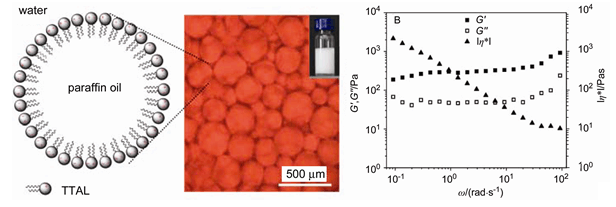| [1] Zhao, G. X.; Zhu, B. Y. The Principle of Surface Active Agents, China Light Industry Press, Beijing, 2003. (赵国玺, 朱步瑶, 表面活性剂作用原理, 中国轻工业出版社, 北京, 2003.)
[2] Tang, Y. Q.; Zhu, L. Y.; Han, Y. C.; Wang, Y. L. Acta Chim. Sinica 2014, 72, 673. (唐永强, 朱琳一, 韩玉淳, 王毅琳, 化学学报, 2014, 72, 673.)
[3] Li, Y. P.; Lü, W. Q.; Cao, X. L.; Song, X. W.; Wang, Q. W.; Li, Y. Acta Chim. Sinica 2014, 72, 615. (李亚娉, 吕韦钦, 曹绪龙, 宋新旺, 王其伟, 李英, 化学学报, 2014, 72, 615.)
[4] Yatcilla, M. T.; Herrington, K. L.; Brasher, L. L.; Kaler, E. W.; Chiruvolu, S.; Zasadzinski, J. A. J. Phys. Chem. 1996, 100, 5874.
[5] Karukstis, K. K.; McCormack, S. A.; McQueen, T. M.; Goto, K. F. Langmuir 2004, 20, 64.
[6] Matos, M. R. A.; Silva, B. F. B.; Marques, E. F. J. Colloid Interface Sci. 2013, 405, 134.
[7] Jose, R.; Patel, T. J.; Cather, T. A.; Willhelm, D. J.; Grebowicz, J.; Han, H.; Bhowmik, P. K.; Sharpnack, L.; Agra-Kooijman, D. M.; Kumar, S. Colloid Surf. A 2014, 461, 40.
[8] Horbaschek, K.; Hoffmann, H.; Hao, J. J. Phys. Chem. B 2000, 104, 2781.
[9] Zemb, T.; Dubois, M.; Demé, B.; Gulik-Krzywicki, T. Science 1999, 283, 816.
[10] Dubois, M.; Demé, B.; Gulik-Krzywicki, T.; Dedieu, J.-C.; Vautrin, C.; Désert, S.; Perez, E.; Zemb, T. Nature 2001, 411, 672.
[11] Li, H.; Hao, J. J. Phys. Chem. B 2008, 112, 10497.
[12] Yang, M.; Hao, J.; Li, H. RSC Adv. 2014, 4, 40595.
[13] Varade, D.; Carriere, D.; Arriaga, L. R.; Fameau, A.-L.; Rio, E.; Langevin, D.; Drenckhan, W. Soft Matter 2011, 7, 6557.
[14] Li, H.; Hao, J.; Wu, Z. J. Phys. Chem. B 2008, 112, 3705.
[15] Li, H.; Xin, X.; Kalwarczyk, T.; Kalwarczyk, E.; Niton, P.; Holyst, R.; Hao, J. Langmuir 2010, 26, 15210.
[16] Li, H.; Xin, X.; Kalwarczyk, T.; Holyst, R.; Chen, J.; Hao, J. Colloids Surf. A 2013, 436, 49.
[17] Schelero, N.; Stocco, A.; Möhwald, H.; Zemb, T. Soft Matter. 2011, 7, 10694.
[18] Margulis-Goshen, K.; Silva, B. F. B.; Marques, E. F.; Magdassi, S. Soft Matter. 2011, 7, 9359.
[19] Sun, D. J.; Li, C.; Mei, Z.; Liu, W.; Su, C.; Yu, P.; Xu, J.; Liu, S. CN 200710113845 2007 [Chem. Abstr. 2008, 148, 588814].
[20] Cohen-Addad, S.; Höhler, R. Curr. Opin. Colloid Interface Sci. 2014, 19, 536.
[21] Wang, J.; Yang, F.; Li, C.; Liu, S.; Sun, D. Langmuir 2008, 24, 10054.
[22] Zhang, J.; Li, L.; Wang, J.; Sun, H.; Xu, J.; Sun, D. Langmuir 2012, 28, 6769.
[23] Zhang, J.; Li, L.; Wang, J.; Xu, J.; Sun, D. Langmuir 2013, 29, 3889.
[24] Vilasaua, J.; Solansa, C.; Gómezb, M. J.; Dabriob, J.; Mújika-Garaib, R.; Esquena, J. Colloid Surf. A 2011, 392, 38.
[25] Futamura, T.; Kawaguchi, M. J. Colloid Interface Sci. 2012, 367, 55.
[26] Nesterenko, A.; Drelich, A.; Lu, H.; Clausse, D.; Pezron, I. Colloids Surf. A 2014, 457, 49.
[27] Li, H.; Wieczorek, S. A.; Xin, X.; Kalwarczyk, T.; Ziebacz, N.; Szymborski, T.; Hozyst, R.; Hao, J.; Gorecka, E.; Damian Pociecha, D. Langmuir 2010, 26, 34. |
